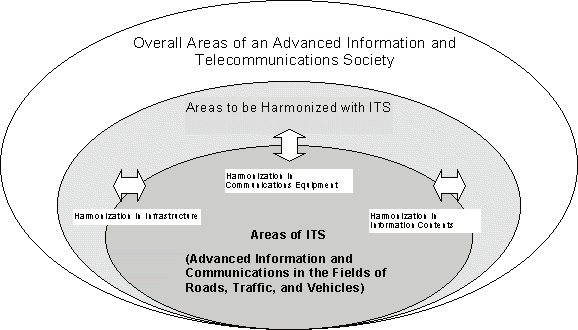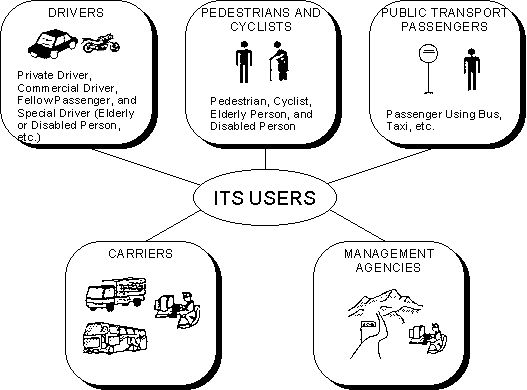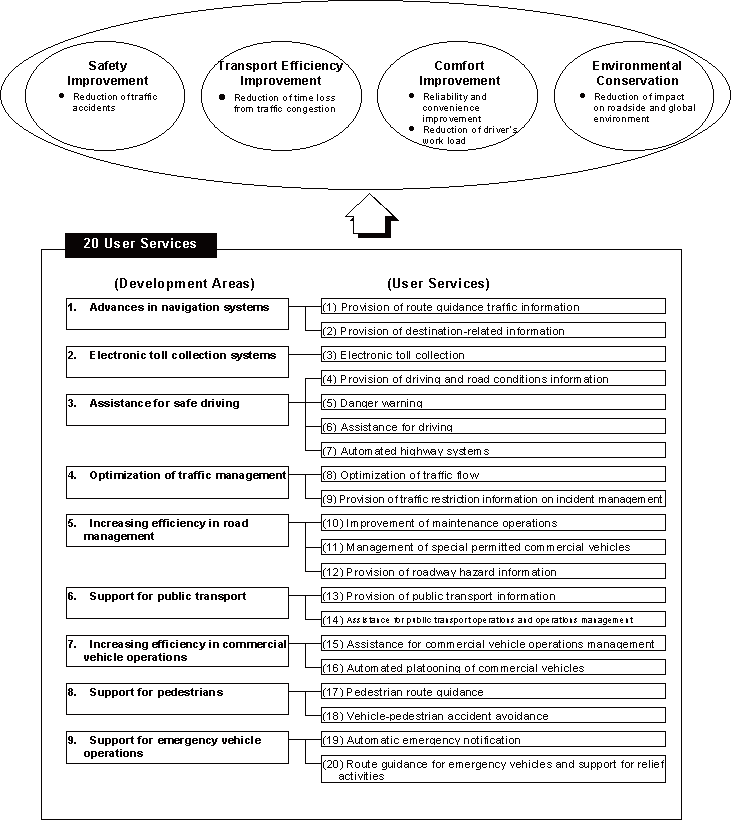
2.1 Advanced Information and Telecommunications Society and ITS
2.2 ITS User Services
(1) What is an Advanced Information and Telecommunications Society?*
An advanced information and telecommunications society is a new socioeconomic system which harmonizes culture, industry, economy, nature and environment by realizing unrestricted production, distribution and sharing of information, knowledge and wisdom, which are the fruits of intellectual activities of humankind.
This system is expected to replace the existing system, which is burdened by institutional fatigue, creating a tide of changes that can be called an "information revolution". This movement will be similar in effect to the former citizens' revolution or industrial revolution, and will result in expansion of economic frontiers, promotion of well-balanced national land development and a kind of life through which people will appreciate more latitude and affluence.
In order to accelerate and promote the structuring of such an advanced information and telecommunications society to pave the way for the 21st century, we must quickly build an advanced information network infrastructure to support production, distribution and sharing of information and knowledge. This scheme requires huge amounts of investments. Not only will the opportunity for industries related to information networks be expanded and their role as leading industries be strengthened, but through revitalization of intellectual and productive human activities, this strategy can create a number of new businesses in every part of the country.
(2) Role of ITS in an Advanced Information and Telecommunications Society
ITS will play an important role in solving road transport problems, which are closely related to people's lives. For this reason, ITS is designated in "Basic Guidelines on the Promotion of an Advanced Information and Telecommunications Society" (as decided in February 1995 by the Advanced Information and Telecommunications Society Promotion Headquarters) as one of the public fields where everyone can enjoy well-developed public services, and where the government plays a leadership role and provides general measures to be implemented according to the plan.
An advanced information and telecommunications society is also a society where information networks in various fields including ITS are contained, and the connection between ITS and information networks in other fields is important. Specifically, it is indispensable to have an information network infrastructure including optical fibers, and advanced roads and vehicles, which are the terminals of information transmission and reception. Expansion of the contents of information for realization of an advanced information and telecommunications society is also required. In promoting ITS, it is important to define and fix the realm to be harmonized with ITS in an advanced information and telecommunications society, with due consideration of (1) securing interoperability of the infrastructure, not only that within the ITS realm, but also those in the realm to be harmonized with ITS; (2) transmitting and receiving terminals; and (3) the interoperability and interconnectivity of the information content.

(1) Significance of Setting User Services
In order to materialize ITS in concrete form as an effective system meeting its objective, it is important to accurately define user needs of various kinds related to ITS and systematize those needs. In total, 20 user services to be offered by ITS were specified. To this end, ITS users were then allocated according to nine different fields of development shown in "Basic Government Guidelines of Advanced Information and Telecommunications Society".
ITS user services illustrate components of the society that will be established by the wide deployment of ITS. The list of ITS user services will serve as a guideline for those concerned with promotion of practical use of ITS while conducting efficient and systematic research and development work and conducting business activities. It will also serve as a reference for understanding the necessity of ITS.
Additionally, reviews will be conducted at appropriate intervals depending on changes in social situations, etc., regarding ITS user services.

(2) Framework of ITS Users and User Services
(a) ITS Users
Five different ITS users were defined: (1) drivers, (2) pedestrians and cyclists, (3) public transport passengers, and (4) carriers, who are categorized as road users, and (5) management agencies, who utilize ITS for road transport management.
(b) Framework of User Services
ITS user services are set by allocating users for each of the nine different development fields in consideration of individual users' needs and conditions under which these needs arise.
| (1) Provision of route guidance traffic information | 1.Advances in navigation systems | Drivers | To obtain traffic information from navigation systems | Travel from starting points to destinations |
| (2) Provision of destination-related information | Obtaining information on and selecting destination | |||
| (3) Electronic toll collection | 2.Electronic toll collection systems | Drivers, carriers, and management agencies | Automatic toll exchange without stop | Toll payment at toll gates |
| (4) Provision of driving and road conditions information | 3.Assistance for safe driving | Drivers | Safe driving | Recognition of traffic conditions |
| (5) Danger warning | Recognition of hazardous incidents | |||
| (6) Assistance for driving | Operation to avoid hazardous incidents | |||
| (7) Automated highway systems | Automated driving | |||
| (8) Optimization of traffic flow | 4.Optimization of traffic management | Drivers and management agencies | Optimization of traffic flow | Traffic management |
| (9) Provision of traffic restriction information on incident management | Adequate measures against traffic accidents | |||
| (10) Improvement of maintenance operations | 5.Increasing efficiency in road management | Management agencies | Immediate and adequate management of road maintenance | Road management |
| (11) Management of special permitted commercial vehicles | Drivers, carriers, and management agencies | Immediate and adequate issue of permits for special vehicle passage | ||
| (12) Provision of roadway hazard information | Drivers and management agencies | Adequate measures against natural disasters, etc. | ||
| (13) Provision of public transport information | 6.Support for public transport | Public transport passengers | Optimal use of different transport modes | Use of public transport |
| (14) Assistance for public transport operations and operations management | Carriers and public transport passengers | More convenient public transport, more efficient management and safer transport | Implementation of fleet management and priority control | |
| (15) Assistance for commercial vehicle operations management | 7.Increasing efficiency in commercial vehicle operations | Carriers | Efficient collection and delivery and safer transport | Implementation of fleet management |
| (16) Automated platooning of commercial vehicles | More efficient transport | |||
| (17) Pedestrian route guidance | 8.Support for pedestrians | Pedestrians and cyclists | More convenient travel | Travel by walking, etc. |
| (18) Vehicle-pedestrian accident avoidance | Safer travel | |||
| (19) Automatic emergency notification | 9.Support for emergency vehicle operations | Drivers | Request for immediate and adequate relief | Request for emergency relief |
| (20) Route guidance for emergency vehicles and support for relief activities | Drivers | Immediate and adequate route guidance to accident sites | Restoration and relief activities | |
Through the provision of user services, ITS makes it possible to reduce the number of traffic accidents and amount of time loss resulting from traffic congestion, and to produce comfortable mobility with high standards of reliability and convenience. Consequently, it is possible for ITS to minimize adverse impacts on roadside environments and on the global environment. Coordinated provision of all user services will improve each respective service and enhance their effects.

(3) Details of ITS User Services
Details of the 20 ITS user services are set out in subsections that follow.
(a) Advances in Navigation Systems
Provision of Route Guidance Traffic Information
The provision of route guidance traffic information makes it possible for drivers to choose the best route to a particular destination and minimize travel time. This user service will improve driver convenience through dispersion of traffic flow. The information will be provided on demand and include the level of traffic congestion on each route, travel times, traffic control information, and parking space availability. Pre-trip information can also be made available at home or the office beforehand. In this way, the system enables one to work out an effective travel plan.
Provision of Destination-related Information
The provision of destination-related information makes it possible for drivers to select suitable destinations for their travel. To enable drivers and passengers to enjoy a pleasant trip, the system provides service information such as regional attractions through an in-vehicle device or kiosks at toll road parking areas, service areas, or train stations along public roads.
(b) Electronic Toll Collection Systems
Electronic Toll Collection
Electronic toll collection enables drivers to pay tolls automatically on a cashless basis without stopping at toll stations, thereby improving driver convenience and reducing labor costs of toll road operators.
(c) Assistance for Safe Driving
Provision of Driving and Road Conditions Information
The provision of driving and road conditions information can prevent accidents during the daytime and when vision is considerably obscured at night and in inclement weather. This system collects a variety of driving conditions information, such as the conditions of the road and vehicles in surrounding areas by means of sensors installed on the road and in the vehicle, and this information is provided to each vehicle driver on a real time basis to enhance the driver's recognition of travel environments.
Danger Warning
Danger warning can prevent collisions or incidents resulting from vehicles deviating from their respective traffic lanes. This system quickly gathers information on the positions and movements of vehicles in the immediate surrounding area, and on traffic barriers ahead of the vehicle by means of sensors installed on the road and onboard the vehicles. A warning is given if dangerous conditions are detected with respect to the position of a vehicle, the distance between vehicles, or travel speeds, thereby supporting the driver's decisions in operating his vehicle.
Assistance for driving
Assistance for driving can also prevent collisions and incidents resulting from vehicles deviating from their respective traffic lanes. This system supports drivers' operations by adding an automatic control function to the previously mentioned danger warning service. The system involves application of automatic speed and steering control if a situation is considered dangerous, in consideration of the driver's own vehicle, other vehicles in the immediate surrounding area and traffic barriers present.
Automated Highway Systems
Automated highway systems can reduce driver work load and prevent traffic accidents. This system is based on automatically controlled driving assistance functions, by applying control over the brakes, accelerator and steering wheel depending on the travel environment in the immediate area. Automated highway systems make it possible to travel safely at a safe speed, by keeping a proper distance from other vehicles.
(d) Optimization of Traffic Management
Optimization of Traffic Flow
Optimization of traffic flow improves traffic safety and comfort and enhances the environment. This system utilizes an optimal signal control not only in areas where the traffic congestion situation is worsening and the environment is deteriorating, but also throughout the road network as a whole. In addition, this system provides drivers with route guidance by means of an in-vehicle device and variable message signs.
Provision of Traffic Restriction Information on Incident Management
Provision of traffic restriction information on incident management can prevent secondary disasters resulting from a traffic accident. This system quickly detects the occurrence of a traffic accident, implements quick traffic control related to the accident, and provides drivers with the new traffic control information by means of an in-vehicle device and variable message signs.
(e) Increasing Efficiency in Road management
Improvement of Maintenance Operations
In order to maintain safe, smooth and comfortable road travel environments, responding to the natural and social conditions in each region, improvement of maintenance operations can accurately determine road surface conditions and the positions of work vehicles, decide the best working time and workers' assignment plan, and provide directions to vehicles. During a natural disaster, the system gathers information on damage to road facilities and the surrounding area, and facilitates proper road management through immediate establishment of restoration mechanisms including an efficient assignment of vehicles to repair damaged roads.
Management of Special Permitted Commercial Vehicles
Management of special permitted commercial vehicles secures preservation of the road structure and prevents traffic hazards. By improving user services while reducing freight and fleet management costs, this system includes applications for passage permits for each special service vehicle and electronic processing of office work, conversion into a database the information on routes where passage is requested, and information on the actual passage route chosen by vehicles requesting passage. The system also includes automatic vehicle weigh-in-motion to expedite the procedures for obtaining permits for special purpose vehicles.
Provision of Roadway Hazard Information
Depending on the natural conditions in each region, provision of roadway hazard information can quickly provide drivers with information on rain, snow, fog, and winds, and even information on the possible presence of waves on coastal roads. In addition, this system provides traffic control information related to such conditions by means of in-vehicle equipment and variable message signs.
(f) Support for Public Transport
Provision of Public Transport Information
Provision of public transport information supports public transport passengers in their selection of travel, transfers, and time of embarkation, thereby improving users' convenience. The system provides real-time information on the situation with respect to public transport congestion levels, fares, other fees, and parking space availability through terminals located at users' homes or offices prior to departure, or through mobile in-vehicle equipment, portable terminals, and message signs or kiosks installed along the road, or at terminals, bus stops and expressway service areas.
Assistance for Public Transport Operations and Operations Management
In order to improve the convenience, safety and smooth operations of public transport, and the efficiency of public transport business operations, assistance for public transport operations and operations management enables the collection of information on public transport operating conditions and implementation of public transport priority measures, as determined necessary. The system provides public transport operators with various important traffic conditions data, thereby supporting public transport operations and management.
(g) Increasing Efficiency in Commercial Vehicle Operations
Assistance for Commercial Vehicle Operations Management
Assistance for commercial vehicle operations management can improve transport efficiency, reduce the volume of commercial traffic, and improve transport safety. This system collects information on truck and sightseeing bus operating conditions on a real-time basis, and provides transport operators with this information in supporting their operations. Also, this system improves the efficiency of freight and fleet management by establishing advanced, automated and systematized logistics centers and by providing information on joint distribution and cargo hauled on the return trip.
Automated Platooning of Commercial Vehicles
Automated platooning of commercial vehicles can realize rapid improvement in transport efficiency, reduction of traffic volume of commercial vehicles, and improvement of transport safety. This system provides commercial vehicles with automated travel functions by keeping proper distances between vehicles.
(h) Support for Pedestrians
Pedestrian Route Guidance
Pedestrian route guidance can create safe roadside environments which can be utilized by pedestrians and cyclists, who are relatively vulnerable to traffic accidents, particularly the elderly or the handicapped. This system assists pedestrians and cyclists by providing facilities where portable terminal units, magnetic voices and sounds are used, and route guidance and instruction signs.
Vehicle-Pedestrian Accident Avoidance
Vehicle-pedestrian accident avoidance can also create safe roadside environments which can be utilized by pedestrians and cyclists. This system provides support for pedestrians and cyclists by extending the green time for pedestrians at signalized intersections by means of portable terminals. Also, when imminent danger is detected in the case of a pedestrian in the path of a vehicle, this system warns the driver of the situation or automatically applies the brakes, thereby preventing collisions involving pedestrians.
(i) Support for Emergency Vehicle Operations
Automatic Emergency Notification
Automatic emergency notification can improve the carrying out of speedy and appropriate first aid activities and/or road repairs in case of a disaster or accident. According to this system, a vehicle involved in such an incident automatically transmits an emergency message to notify concerned dispatch centers and emergency stations, and thereby greatly shortens the time for recognizing, locating, and treating a disaster or accident.
Route Guidance for Emergency Vehicles and Support for Relief Activities
Route guidance for emergency vehicles and support for relief activities can also improve the speed of carrying out appropriate first aid activities and/or road repairs in case of a disaster or accident. This system collects information on the traffic situation and damaged road conditions on a real-time basis, and quickly notifies organizations concerned and guides emergency and repair vehicles to the scene of a disaster or accident.
|
| |
All Rights Reserved, Copyright © 2004 Ministry of Land, Infrastructure, Transport and Tourism |